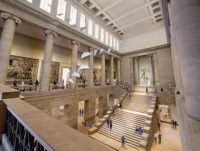Hoisting golden ceremonial shovels emblazoned with the face of Dwight D. Eisenhower, family members, politicians, and commissioners of the Eisenhower Memorial broke ground with architect Frank Gehry on Thursday. Sited just off Washington, D.C.’s National Mall but with direct views of the Capitol, the memorial will celebrate Eisenhower’s humble beginnings as a boy from Abilene, Kansas, through his rise to Supreme Allied Commander and President of the United States.
Gehry’s design for the four-acre memorial has not been without controversy. The memorial’s largest feature, a 447-foot-long, 80-foot-tall tapestry along the northern facade of the Department of Education, was called to question for both its content and its material qualities during a multi-year legislative struggle for requisite approvals. The focus on Eisenhower’s modest upbringing, celebrated with a central sculpture of Ike as a young boy, struck a nerve with those that felt he should be remembered for his leadership later in life.
But the Eisenhower family and the memorial design team, which is a joint venture between Gehry Partners and AECOM, reached a compromise late last year to shift the focus of the tapestry from a depiction of Eisenhower’s hometown to an abstracted image of the Normandy beaches in peacetime. New designs for the work, which will be woven with stainless steel cables by artist Tomas Osinski, were released in January. Likewise, the memorial core’s sculptural elements (by Sergey Eylanbekov) now depict Eisenhower delivering pre-D-Day inspiration to paratroopers, and as 34th President of the United States, with the boyhood statue looking on from a less prominent perch along a low wall etched with his name. The memorial received $45 million in federal funding through the congressional budget bill passed in May of this year to begin construction.
At the ceremony, Dwight D. Eisenhower’s granddaughter, Susan Eisenhower, thanked Gehry and his team for “their professionalism, their hard work, and their flexibility” in creating the memorial. “To many, it seems we’ve traveled a long road to get to this point,” she said. “And yet, believe it or not, by historic standards, we’ve arrived here all in good time. The FDR Memorial took 43 years, so I’d say we’re way ahead of the timeline.” (The Eisenhower Memorial Commission was created by Congress on October 25, 1999.)
“We’ve waited so long and been through so much on it,” Gehry said after the ceremony. “But compared to other memorials, I think we’re half the time! All of us and everything that went on, I always believed in the Eisenhower family.”
In an official press release from the Eisenhower Memorial Commission, Gehry wrote about his personal connection to Eisenhower through the experiences of family members whose lives were lost in Germany leading up to World War II:
“This project has been an enormous honor for me both professionally and personally. I was 16 years old when Eisenhower defeated the Nazis and led American to victory in WWII. I had lost 33 members of my family in the camps, so his victory was all the more meaningful to me. His leadership in peacetime was as inspiring. He led the country with strength, but also with great humanity and humility. I hope that these values are captured in the memorial, and that it will be a place to honor and to learn from one of the greatest heroes that the world has ever known.”
Senator Pat Roberts, a Republican from Kansas who serves as the chairman of the Eisenhower Memorial, closed the ceremony by holding up a prop building permit from the National Park Service to signal an immediate start to construction. He also announced the memorial’s dedication ceremony, which is currently set for May 8, 2020—the 75th anniversary of VE Day.
Read Architectural Record’s full coverage of the Eisenhower Memorial.














Post a comment to this article
Report Abusive Comment